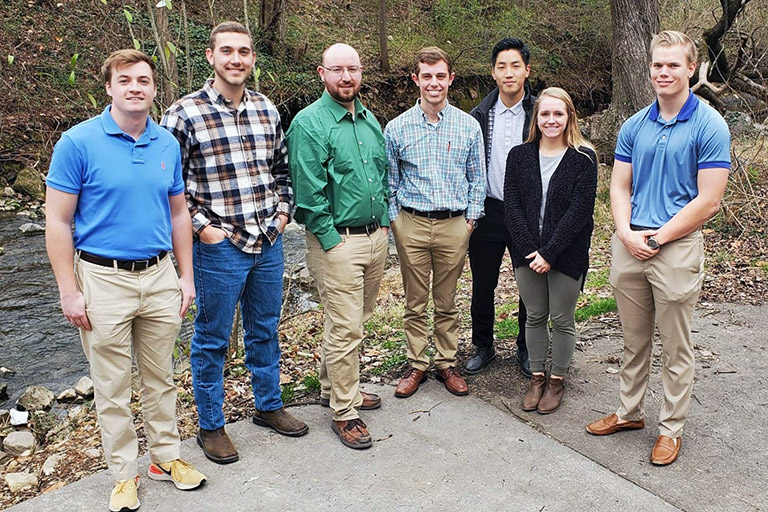
Boathouse Bridge
Senior design projects offer undergraduate students an unprecedented opportunity to apply their knowledge and skills in real-world projects that have a lasting impact on their surrounding communities.
One CEE team worked on a project very close to home: a pair of bridges on the university’s campus. Their efforts earned them the overall senior design award.
The team, consisting of Alex Shafer, Cole Emmett, Russell Edens, Adam Litton, Sammy Son, Hunter Arwine, and Tristen Keller, developed demolition and redesign solutions for the Min Kao and Boathouse Bridges that cross Second Creek. Partners included UT Facility Services, Haines Structural Group, City of Loudon, Jones Brothers Contractors, and Cannon & Cannon.

Pictured left to right: Hunter Arwine, Cole Emmett, Adam Litton, Russ Edens, Sammy Son, Alex Shafer, and Tristen Keller.
The Boathouse Bridge, which is buckled and sinking to the water line, had the added challenge of existing structures overhead, including Neyland Drive and a railroad bridge. The existing infrastructure obstructed access to the site and increased the distance that the construction equipment had to span, therefore the team had to make sure that the design made sense and could actually be built.
Shafer, the team lead, noted that this project was all about the team effort.
“In class, we learn pieces of technical information, and the project really required us to put the technical skills together,” he said. “The design process consists of many components that have to be considered and this project put that into perspective. Every member contributed different skills, and it was really cool to see the different components of the project come together.”
At first, the costs associated with the demolition and construction seemed outsized compared to the benefit, until the team hosted forums with the community and received feedback that showed that not fixing the bridge would pose a liability.
During high traffic events, the bridge is the only way to safely cross the street, making the construction of a new bridge a matter of safety and a benefit to greenway users, students, faculty, and UT fans.
For the Min Kao Bridge, the team did a flood analysis to determine the current water elevations and confirm compliance of the proposed design in accordance with codes enforced by the City of Knoxville. They also conducted a soil analysis to determine soil-bearing capacity at the site.

Min Kao Bridge
Edens headed up the floodwater analysis portion of the project, which included creating a model of both existing and proposed conditions of Second Creek. That data was used to determine the impact that raising the Min Kao Bridge would have on the water surface elevations for 100-year and 500-year flood events.
“Water resources was not one of my concentrations, so I had a lot to learn,” he said. “One of the most important things I learned is how to perform a flood study. The most significant aspect of this was how to use HEC-RAS (a computer-based hydrology modelling program) and accurately model a stream during different flood events.”
For both sites, the team had to identify the necessary permits and best management practices applicable to the project. Emmett was the environmental lead who noted that the environmental work included a trash remediation plan to fix the trash buildup at the boathouse bridge.
“This wasn’t my ideal project for my concentration,” said Emmett. “However, I did gain experience developing permits, which might be something I have to do in the future as I am pursuing a master’s degree in environmental engineering.”
The team’s final package included a construction-ready set of drawings, a construction schedule, and estimate of probable cost for the completion of the projects.